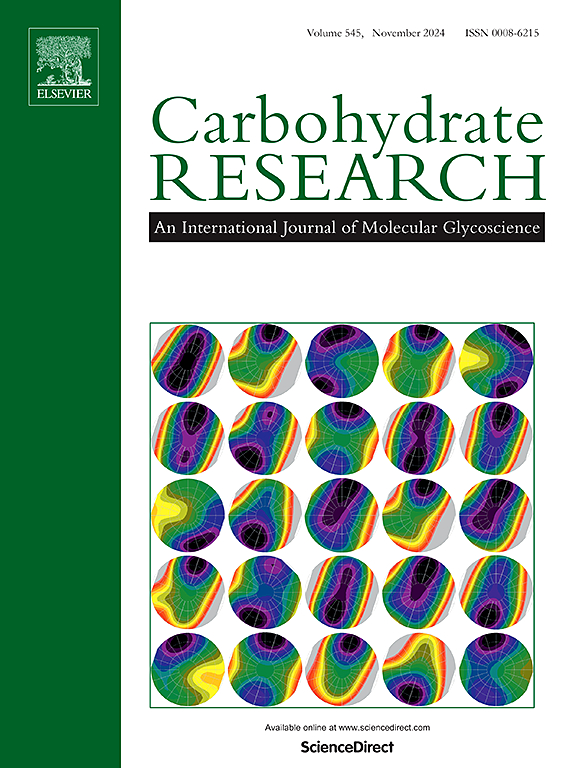三嗪修饰壳聚糖作为一种增强亲水性和基因递送的策略。
IF 2.4
3区 化学
Q3 BIOCHEMISTRY & MOLECULAR BIOLOGY
引用次数: 0
摘要
在这项研究中,我们研究了用三尖杉碱修饰壳聚糖对转染效率的影响,即保持壳聚糖与质粒 DNA(pDNA)形成复合物的能力并增加其亲水性。壳聚糖固有的局限性,如在生理 pH 值下溶解性差、细胞摄取不足以及与 pDNA 的强离子相互作用等,通常会导致转染效率低下。为了克服这些挑战,我们将含有仲胺基团的亲水分子三尖杉碱与壳聚糖共轭。用三尖杉碱修饰了三种不同分子量(低、中、高)的壳聚糖。利用傅立叶变换红外光谱(FTIR)和核磁共振(NMR)分析对改性壳聚糖进行了结构表征。从亲水性/疏水性、质子缓冲能力、粒度、PDI 和 zeta 电位等方面评估了三尖杉碱修饰的效果。对经三尖杉碱修饰的低分子量壳聚糖纳米颗粒(nLMWChiTri)的 pDNA 复合物能力、细胞毒性和体外转染效率进行了评估,结果表明三尖杉碱修饰的低分子量壳聚糖纳米颗粒适合用于基因转移研究。结果表明,三尖杉碱修饰增强了壳聚糖的基因转移潜力,使其与商业转染剂 Lipofectamine™ 2000 相比具有竞争力,为非病毒基因治疗应用提供了一种前景广阔的策略。此外,壳聚糖的生物相容性和生物可降解性,再加上三尖杉碱改善的亲水性,使 nLMWChiTri 成为一种更安全、更可持续的选择,可反复用于基因递送,克服了 Lipofectamine™ 2000 等其他合成载体的主要局限性。本文章由计算机程序翻译,如有差异,请以英文原文为准。

Tricine-modified chitosan as a strategy for enhancing hydrophilicity and gene delivery
In this study, we investigated the effect of chitosan modification with tricine on transfection efficiency by preserving its ability to form complexes with plasmid DNA (pDNA) and increasing its hydrophilicity. The inherent limitations of chitosan, such as poor solubility at physiological pH, insufficient cellular uptake, and strong ionic interactions with pDNA, typically result in low transfection efficiency. To overcome these challenges, Tricine, a hydrophilic molecule containing a secondary amine group, was conjugated to chitosan. Chitosan of three different molecular weights (low, medium, and high) was modified with tricine. Structural characterization of the modified chitosan was conducted using Fourier Transformed Infrared Spectroscopy (FTIR) and Nuclear Magnetic Resonance (NMR) analyses. The effects of tricine modification were assessed in terms of hydrophilicity/hydrophobicity, proton buffering capacity, particle size, PDI and zeta potential. Tricine modified low molecular weight chitosan nanoparticles (nLMWChiTri), which exhibit suitable properties for gene transfer studies, were evaluated regarding pDNA complexation ability, cytotoxicity and in vitro transfection efficiency. The results demonstrated that tricine modification enhanced the gene transfer potential of chitosan, making it competitive with the commercial transfection agent Lipofectamine™ 2000 and offering a promising strategy for non-viral gene therapy applications. Furthermore, the biocompatibility and biodegradability of chitosan, combined with the improved hydrophilicity provided by tricine, makes nLMWChiTri a safer and more sustainable option for repeated use in gene delivery, overcoming the major limitations associated with other synthetic vectors such as Lipofectamine™ 2000.
求助全文
通过发布文献求助,成功后即可免费获取论文全文。
去求助
来源期刊

Carbohydrate Research
化学-生化与分子生物学
CiteScore
5.00
自引率
3.20%
发文量
183
审稿时长
3.6 weeks
期刊介绍:
Carbohydrate Research publishes reports of original research in the following areas of carbohydrate science: action of enzymes, analytical chemistry, biochemistry (biosynthesis, degradation, structural and functional biochemistry, conformation, molecular recognition, enzyme mechanisms, carbohydrate-processing enzymes, including glycosidases and glycosyltransferases), chemical synthesis, isolation of natural products, physicochemical studies, reactions and their mechanisms, the study of structures and stereochemistry, and technological aspects.
Papers on polysaccharides should have a "molecular" component; that is a paper on new or modified polysaccharides should include structural information and characterization in addition to the usual studies of rheological properties and the like. A paper on a new, naturally occurring polysaccharide should include structural information, defining monosaccharide components and linkage sequence.
Papers devoted wholly or partly to X-ray crystallographic studies, or to computational aspects (molecular mechanics or molecular orbital calculations, simulations via molecular dynamics), will be considered if they meet certain criteria. For computational papers the requirements are that the methods used be specified in sufficient detail to permit replication of the results, and that the conclusions be shown to have relevance to experimental observations - the authors'' own data or data from the literature. Specific directions for the presentation of X-ray data are given below under Results and "discussion".
 求助内容:
求助内容: 应助结果提醒方式:
应助结果提醒方式:


